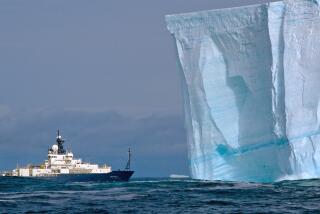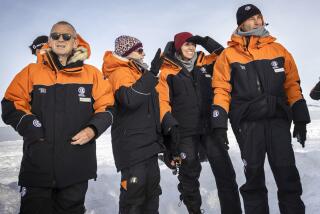Getting to Antarctica: No One Just Goes There
- Share via
Outfitting a diplomatic conference for the interior of Antarctica presents its own problems. As the 58 scientists and diplomats--four of whom were women--discovered on their recent meeting near the coast of the Ross Sea, no one just goes to Antarctica.
Although the U.S. government and several private foundations paid most of the expenses of the trip, each participant was required to furnish the results of a thorough medical examination. Each person was checked for infectious diseases, given an electrocardiograph test and examined for possible dental problems.
There was some grumbling--one member of the party said he spent two days in a doctor’s office and $300 in fees to discover that he was in fine shape--but the organizers of the trip said the precautions are standard for Antarctica.
“Medical evacuations from Antarctica are extremely expensive and hazardous,” said Timothy Hushen, staff director for the Polar Research Board and coordinator for the trip. “We wanted to reduce the risk of that as much as possible.”
The meeting participants gathered first in Christchurch, New Zealand, headquarters of the U.S. Antarctic Research Program. There each person was outfitted with two canvas bags full of polar gear, courtesy of the National Science Foundation. The bags included everything from long underwear and fleece-lined pants to a dashing wool scarf and a pair of white rubber “bunny” boots.
The day before departure, the conference members went through an hourlong practice dressing session, discarding their street clothes for the foundation’s multilayered clothing. And then they put most of it on again the next day for the 10-hour flight to the Beardmore South Camp. Strapped into the bench seats of a U.S. Navy C-130 Hercules, the identically dressed participants looked more like an aging military assault team than an international collection of diplomats and scientists.
The requirement of wearing arctic gear in the transport planes has a purpose. Over the years of Antarctic exploration and scientific endeavors, more than 50 planes have crashed on the continent. Without such clothing, the chance of survival after such a crash would be negligible.
These rigors are experienced every year by the several thousand scientists and support personnel who operate the four U.S. bases in Antarctica. But for the conference members there were some exceptions to traditional Antarctic hardships. The Beardmore South Camp came equipped with a no-charge bar, tended by obliging conference participants through much of the afternoon and evening but available 24 hours a day for those willing to pour their own.
The camp, located on an isolated glacier 450 miles from the main U.S. base at McMurdo Sound, also came equipped with all the accouterments of the modern conference. Courtesy of the huge ski-equipped Hercules aircraft, the participants could make use of slide and opaque projectors, a public address system, IBM Selectric typewriters and a photocopier for making corrections in speech drafts.
For some, there was almost too much technology. The slide shows, paper presentations and debates wore on for so long that an anonymous rebel scrawled on a blackboard: “Help Save Antarctica--Bore a Lawyer to Death.”
But if the days were sometimes tedious, the evenings often were spectacular. Camp cook Michael Brashear would fire up his outdoor barbecue and feed his charges steak and lobster followed by fresh strawberries and kiwi fruit from New Zealand. Since the sun blazed 24 hours a day, dinner was usually followed by long walks on the glacier or a night at the bar.
The bar scene was dominated by a group of OAE’s: Old Antarctic Explorers, most of them veterans of the International Geophysical Year in 1957-58 when Antarctica was first subjected to serious science. They told of spending months on the Ross Ice Cap with dog teams, mapping the flow of ice. Of making Manhattans by dissolving lifesavers in straight rum. Of falling into crevasses. Of the time a supply airplane mistook their tents for a landing marker and almost mowed them down.
“It’s not the same now,” said Trevor Hatherton, a New Zealand geophysicist. “Everyone goes by plane and helicopter. There are even women in Antarctica now.”
More to Read
Sign up for Essential California
The most important California stories and recommendations in your inbox every morning.
You may occasionally receive promotional content from the Los Angeles Times.













